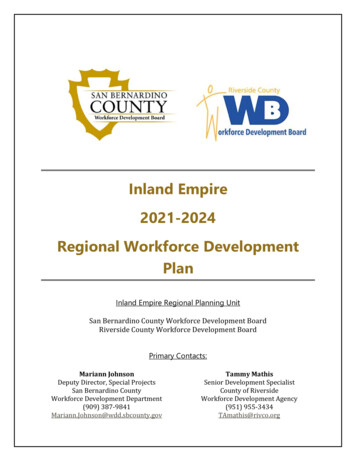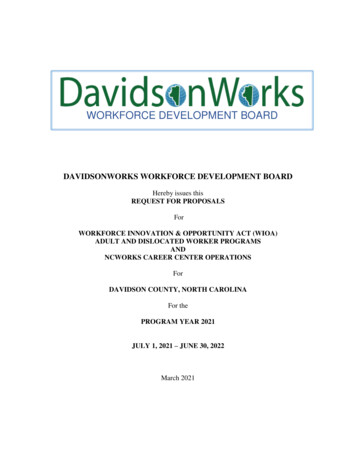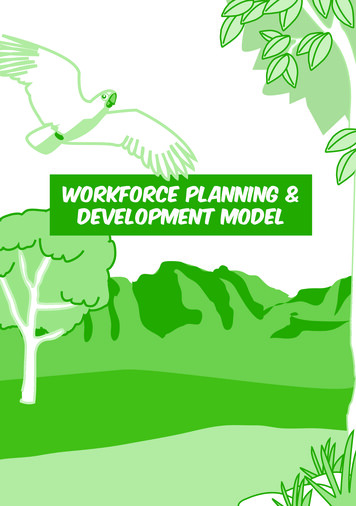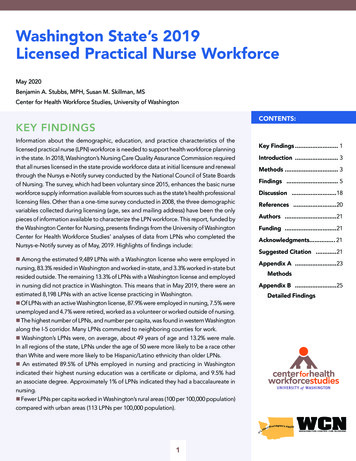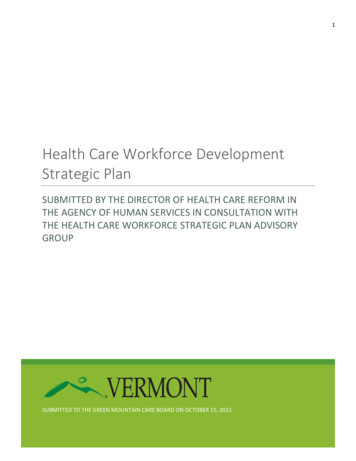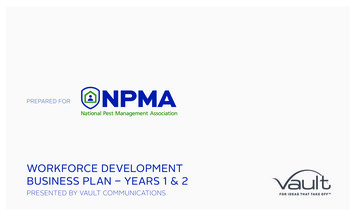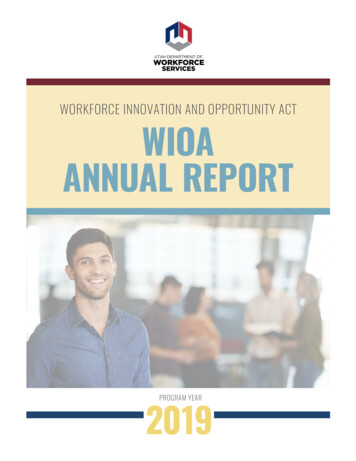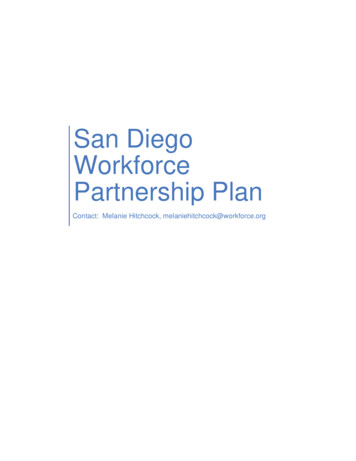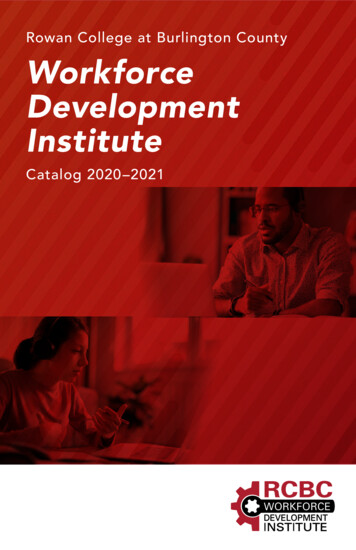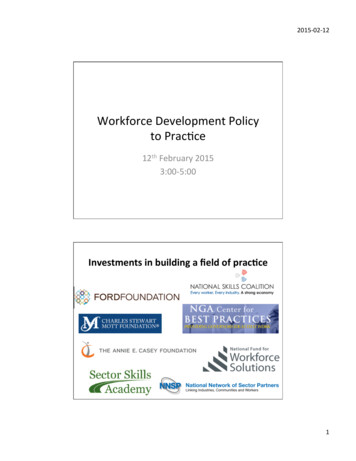
Transcription
lding(a(field(of(prac6ce(1&
��ni9on(s) && Targets&a&specific&industry&or&set&of&occupa9ons& f&organiza9ons& yers& Improves&ability&of&workers&to&get&beQer&jobs& Creates&systemic&change*&2&
g&&&Raise the Floor and Build edules&3&
ilwaukee((WRTP/BIG(Step)( Launched&in&1992&Par9cipants&Served:&3,000 &investors.&Programs&– Pre%employment&training&cer9ficate&programs&– ts&– 012& & 17.80&– (–(San(Antonio( Launched&1992&Par9cipants&Served:&5,000 &investors.&&Programs&– Academic&prepara9on&training&– College%based&occupa9onal&training&&– Case&management&services&Results&– 012& & 19.&65&– Form&small&“buzz”&groups&2&or&3&people& is&dissonant?&&Not&so&relevant?&&&4&
2015%02%12&Building a 21st Century Workforcethrough productive holas,&NYC&February 2015AGENDAHISTORY & MISSION2. Sector Model3. Program Components4. System Change Goals1.5&
2015%02%12&Mission History Per Scholas is a nonprofit organization, committed to breaking the cycle ofpoverty by providing education, technology and economic opportunities toindividuals, families, and communities Founded in 1995, Per Scholas uses technology to address the skills gapand offers employers in the IT community qualified talent to grow theirbusinesses Per Scholas has trained 4,500 adults (18 ) for IT professions in theBronx and Brooklyn, NY; Columbus and Cincinnati, OH; and now theNational Capital Region in Silver Spring, MD 2010: Random assignment (“gold standard”) evaluation 2012: Named to Social Impact Exchange S&I100, a national index of thetop 100 proven, high-impact nonprofits 2014: Featured by the White House as “what works” in fighting long-termunemployment and creating #OpportunityForAllMeasurable Impact&& Accomplishments&– Trained&over&5,000&adults&(18 Spring,&Maryland.&– &rates&(A &and&Net ware&tes9ng&roles.&– gs&– east&10%&within&1&year&of&working&(increase&in& 4% 6&per&hour&in&wages)&6&
2015%02%12&Value Proposition to Employers Pipeline of talent, tailored to need Lower hiring costs Higher retention lower turnover costs Healthier bottom lineEmployer Driven Training ModelPopulation ServedRecruitment andAssessmentProgram Curriculum2-year Follow-Up Ages 18 unemployed, underemployed Youth (18-24) Veterans, Women, and Long Term Unemployed Individuals must have GED or HS Diploma Interviews conducted to gauge interest in career intechnology Process is selective A and Network Certification Training (13 weeks)A and CCNA Certification Training (18 weeks)Software testing Training (8 weeks)Career Development training Wrap-around and employer-assist services Connection to post secondary education Advanced certifications offered depending on funding7&
2015%02%12&Program ment(Students'receive''“wrap around”'support'services!during'CompTIA'A Scholas'for'advanced'training'(e.g.'Network ,'Security ancement&Pathways&CompTIA&A &cer9fica9on&A /Network list&Network&Administrator&Junior&Tester& 28% 32K/year& 40% 45K/year& 32% 40K/year&CompTIA&Network& &cer9fica9on&Cyber&Security/&Security 9ng&Training& 30%34K/year& 50K/year & 55% 65K/year&8&
2015%02%12&PER SCHOLAS VISION: 2015National ation/R&D IT certification inseveral training tracks,life skills, jobplacement and followup services to 1000adults (18 ) annually Diversification into newentry-level IToccupations withnational demand:software testing,software development,web development Footprint in 5 satellitecities serving 100 peryear and 500 in NYC Focus on supportservices: financialeducation,advancement coachingYouth WorkforceDevelopment IT training in softwaretesting to 100 highschool studentsannually in NYC Creating a literacybridge programs for18-24 year olds toaccess training tracksand succeed at higherrates throughadditional supports Capacity building forserving women,veterans, youthThe UDC 80%&of&graduates&paying& las&to&sustain&the&STEP&offering.&9&
2015%02%12&Youth Program s&NATIONAL REPLICATION: SITESELECTIONVIABILITY INDICATORS Labor Supply: 40% of population with HS degree or less Market Demand: 3:1 ratio on projected IT jobs Sustainable Funding: 50% of 3 years of funding prior to entry ( 750K) Local Partner: Providing complementary programmingSiteLaunch DateResults/Next StepsKey PartnersColumbus, OHOctober 2012 launch81 enrolled; 88%graduation and 81%placement ratesJPMC, City Council,United Way, Time WarnerCable, NationwideCincinnati, OHAugust 201318 enrolled, 100%graduationUnited Way, Partnershipfor a CompetitiveWorkforce, Pomeroy,Urban LeagueSilver Spring, MDMarch 2014Recruiting candidatesCatholic Charities,Lockheed MartinDallas, TXQ1 2015Launch siteJPMC, United Way, TexasInstruments, Capital One,Commit! DallasAtlanta, GAQ3 2015Site due diligenceTBD: Home Depot,KForce, InvestAtlantaTBDDetroit, Newark, IndianapolisQ1 2016Site due diligenceTBD: WIN SE Michigan,Prudential, Liberty Mutual10&
2015%02%12&Employment&Engagement& nsor&support& tor&&Per&Scholas,&NYC&akamath@perscholas.org& 1&718&772&0635&11&
r&of&Programs&and&Evalua9on&About&CEO&Center for EconomicOpportunity– &agenda.&– on Fund– 100&million&public%private&partnership.&Commitment to Data &Evaluation– All&program&outcomes&tracked.&– – erm&evalua9ons.&– Annual&budget&decisions&based&on&performance:&– ecific&agency&or&ac9vity&– urces&for&new&ideas&12&
2015%02%12&How&We&Work&Center for Economic Opportunity– e&City&agencies.&– s&to&measure&results.&– – s&&– ers,&and&program&implementa9on.&Providers– refer&to&other&services.&Independent Evaluators– nce&Monitoring&Overview&CEO is a data-driveninstitution( targets,&implementa9on,&and&evalua9on& 9fy&service&gaps&& ough&data&collec9on&PerformanceMonitoring Process( Rigorous(Program(Management& Check%ins,&site&visits,&phone&calls&%& Not&just&data&alone& Qualita6ve(and(Quan6ta6ve(Reports& &next&steps;&& ry Team( mplementa9on,&evalua9on,&and&budget& data&collec9on,&management,&and&repor9ng&&13&
e&on&effec9veness&Types&of&Assessment&All are programsassessedevaluationconducted afterprogram hasbeen up andrunning. sed&on& Availability&of&data& Implementa9on&status& Timing&of&expected&outcomes& Level&of&investment&Bringing to Scale / Dissemination of Best s&events&to&share&findings& &&&systems& rograms&STRATEGYStableemploymentand careeradvancement toprovide a clearpathway out ofpoverty.Robustemployerconnections andlabor marketdata informservices andtraining.CEO PROGRAMSEVALUATION RESULTSSector-Focused Career Centers(SBS) are job placement andtraining centers that focus on asingle economic sector. Each centerstrives to meet the specific employerneeds of that sector and to providelow-income workers with access tojobs with career advancementopportunities.Sector-Focused Career Centers.Participants are placed at higher ratesand have higher wages over 4quarters post-program, as comparedto Workforce1 Center’s clients.Advance at Work (SBS) increasedincome for employed low-wageworkers through job upgrades,access to work supports, and assetbuilding activities.Advance at Work. Participants havehigher placement rates, higher hourlywages, and more weekly hours, ascompared to the traditional Workfore1Centers clients.Jobs-Plus at Jefferson Houses(CUNY, HRA, NYCHA) is anevidence-based employmentprogram targeting public housingresidents. This place- basedprogram offers employment andtraining services, outreach, andincentives designed to help “makework pay.”Jobs-Plus. MDRC’s study of theprevious national pilot demonstratedincreased earnings for residents for atleast seven years after the program’sfull implementation, relative to acontrol group.SIF PROGRAMSWorkAdvance is a blended modeldesigned to assist adults obtainemployment in targeted sectorsthat have room for advancement.The program is offered in NewYork City, Cleveland andYoungstown, Ohio, and Tulsa.Jobs-Plus seeks to raise andsustain the level of employmentand earnings among residents ofpublic housing developments.Services are tailored to residents’individual needs and draw from amenu of on-site and referralservices. The program will beoffered in New York City and SanAntonio.14&
&Westat Report: Y FINDINGS1. d& to& 15,130&for&matched&WF1CC&par9cipants.&2. portuni9es)&&3. 00&Impact &14.5***&90&80&Impact& &15.3***&65.9&70&60&52.9&51.4&50&Impact &0.8&40&Impact& &12.8***&Impact& &14.7***&37.6&66.3&53.5&48.5&33.8&30&13& 13.8&20&10&0&Employed&in&quarter&1&4. ed&all&4&Average&quarter&1&and¬& ance:&Next%Genera9on&Ini9a9ve&Sector-Focused Strategies* Advancement tuni9es&&Effec9ve&screening&&& ( Post%employment&Services& On%going&job&development&and&skill&building&& r&Centers&Evalua9on&Value(Chain(yerploEml coodeinprmsnfout iall kills(Career(Plans(eAaluhVdddeughrots tpacScreening(Post(Placement(Im15&
2015%02%12&Pre%Employment&Services&and&Training& &Background&According&to&Employer&Need&( Pre%Employment&Services&&– real&9me&labor&market&informa9on&– Develop&individual&career&plan& Occupa9on%Specific&Skills&Training&– oyers&– Intensive&enough&to&impart&value&added&– opment&and&Placement&! &! tor&! dustry&! l&! Target&good&paying&jobs&16&
2015%02%12&Post%Placement&Assistance& Career&naviga9on&to&maintain&and&extend&gains&– Career&coaching&– tuni9es&to&promote&career&progression&– Rapid&re%employment&for&those&losing&jobs&– � ork&Advance:&Implementa9on&Findings&MDRC Report: el&for&Low%Skilled&Adults,&2014&Implementation Findings: anizational Lessons is&17&
stomizedCustomizedTrainingTrainingNYCCustomized Training: is a competitive awards program offered through NYC Department of SmallBusiness Services that funds NYC businesses to train their workers and increase their business’productivity. The program is funded by the Workforce Investment Act (WIA) and the Center for EconomicOpportunity (CEO).Program Structure Awards cover up to 70% of the training costs ( 400k max). Trainings aligned to one or more of the following areas:1. Purchasing equipment or software2. Providing new services or products to new markets3. Training staff on new responsibilities4. Updating obsolete skills to keep businessescompetitiveTraining Benefits for a Business: Increasing ProductivityEmployee Recruitment & RetentionAttracting & Retaining CustomersScreme Gelato Bars Founded in 2008 20 employees 2011 Revenues: 800,000 Award: 21,808Program Outcomes Since 2007 the program has awarded 7 million to 142 businesses to train over 3800 workers.970 workers have received a wage gain.The average wage gain has �&development.&External Evaluation Impacts: CT&par9cipants&earned&9%&( ated&in&other&training&programs.&& :ributed(to(the(programI(not(to(other(factors.&& orkers.&&18&
212.341.0173(19&
&20&
Assessment Process is selective A and Network Certification Training (13 weeks) A and CCNA Certification Training (18 weeks) Software testing Training (8 weeks) Career Development training Program Curriculum
